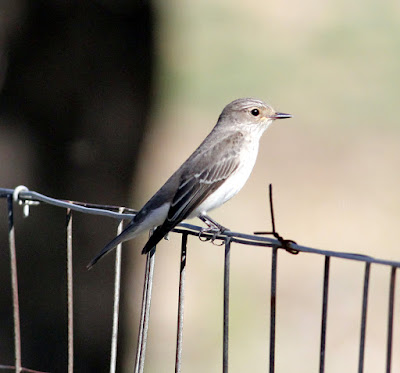I managed an hour two exploring Fluke Hall today. Whooper Swans are back from Iceland with four adults and a single juvenile below the sea wall. There was a Green Sandpiper along the landward ditch, a single Snipe, a couple of hunting Kestrels plus 2 Little Egrets and a Grey Heron.
Best I could find around the woodland turned out to be 45+ Woodpigeon, 3 Stock Dove and a Nuthatch.
That snippet of local news rather short changes regular readers so for the rest of this post there are some final pictures from our Skiathos holiday of 16th to 30th September.
Best I could find around the woodland turned out to be 45+ Woodpigeon, 3 Stock Dove and a Nuthatch.
Whooper Swans
That snippet of local news rather short changes regular readers so for the rest of this post there are some final pictures from our Skiathos holiday of 16th to 30th September.
We chose a sunny day to make the annual pilgrimage to the ancient abandoned fortress of Kastro where we could watch the exploits of the island’s Eleonora’s Falcons. For a more detailed insight into both Kastro and its Eleonora's Falcons, see my post of last year Fantastic Falcon.
The colony of breeding Eleonora’s live on a rocky outcrop in the far north of the island, the opposite coast to both our hotel and to Skiathos Town. Luckily we made the tortuous overland journey before the historic storms of 22/23rd September as otherwise I think the route via secondary roads and rough tracks would have been blocked by rivers of mud and rocks.
The colony of breeding Eleonora’s live on a rocky outcrop in the far north of the island, the opposite coast to both our hotel and to Skiathos Town. Luckily we made the tortuous overland journey before the historic storms of 22/23rd September as otherwise I think the route via secondary roads and rough tracks would have been blocked by rivers of mud and rocks.
The parking spot leaves a foot-slog over rocky paths towards the Greek flag with chance to see Yellow-legged Gulls, Blue Rock Thrush, Kestrel, Alpine Swifts, Common Swifts and swallows of both the common and red-rumped variety. In the vegetation skulked Willow Warblers, Chiffchaffs, Sardinian Warblers and Blackcaps.
The falcons live below the flag along the furthermost point of the rocky promontory where they remain fairly distant until one or two fly directly over. The Eleonora’s performed to their usual incredible and spectacular level, hurtling through the skies at breakneck speed to the rocks and the sea below. With approximately 20 birds present, both adults and youngsters, it was obvious there was lots of family interplay to get through before they fly to Africa for the coming winter.
On a couple of occasion we drove to Koukounaries to visit the famous beach and the lake of Strofilia which lies between a line of pine trees and the road to Koukounaries.
A couple of leisurely walks around the lake taking in the mix of habitats produced a good selection of species with Yellow Wagtails and Whinchats in abundance, on one day in particular 50+ Yellow Wagtails and 20+ Whinchats.
There was also Garden Warbler, Blackcap, Willow Warbler, Chiffchaff, Hoopoe, Red-backed Shrike, Hobby, Grey Heron, Honey Buzzard, Spotted Flycatcher, Wryneck, Kingfisher, Little Egret, Kestrel and Sardinian Warbler. That’s a worthy list by any standards, especially considering that by mid to late September many species are absent having set off for Africa.
There was also Garden Warbler, Blackcap, Willow Warbler, Chiffchaff, Hoopoe, Red-backed Shrike, Hobby, Grey Heron, Honey Buzzard, Spotted Flycatcher, Wryneck, Kingfisher, Little Egret, Kestrel and Sardinian Warbler. That’s a worthy list by any standards, especially considering that by mid to late September many species are absent having set off for Africa.
A Hoopoe is a striking bird but they can be difficult to spot when they choose to stay quiet and sit motionless in a tree.
Yellow Wagtail
I hope blog readers enjoyed the recent posts from Skiathos, Greece. It’s a peaceful, stress-free place for a holiday and there's always a spot of leisurely birding available for those who choose not to sun bathe.
Skiathos
Stay tuned to Another Bird Blog for more birds and more pictures very soon.
Linking this post to Run-a-roundranch blog and World Bird Wednesday.
Linking this post to Run-a-roundranch blog and World Bird Wednesday.













































































